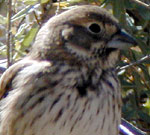By Mary Losure
Minnesota Public Radio
June 21, 2002
At an EPA workshop in Bloomington, one of the discussions about global climate change involves the fate of the region's birds in an artificially warmed world.
| |
|
|
|
||
Much of the research on the possible effects of climate change has centered on forests and crops. But now, scientists are beginning to study how it might affect birds. They've known for years that the breeding ranges of some migrating birds shift from year to year according to weather conditions.
Jeff Price,a researcher for the Virginia based-conservation group American Bird Conservancy, cites the example of a grassland bird known as the lark bunting.
"In most years there aren't a whole lot of lark buntings in Minnesota, because it's too wet for the range of lark buntings. However in really dry years, say the drought of 1989, lark bunting --- the whole range of lark buntings --- shifted east, so you had many more lark buntings in Minnesota than you normally do," he explains. "And as the conditions went back more towards normal, the range of lark buntings shifted west."
But if weather patterns change permanently, the breeding ranges of many types of birds could too. In North America, they are expected to shift northward, or to higher, colder elevations. Price has been using computer models to predict those future ranges. For bird watchers, they're discouraging news.
Baltimore orioles may leave Baltimore. Iowa's state bird, the goldfinch, could vanish there. Minnesota could lose such beloved summer visitors as rose-breasted grosbeaks and many types of warblers.
And these changes also pose a larger problem. In new ranges, birds may be unable to find the habitat they need. Grassland birds could be forced north into forests, for example.
Already, even in their normal ranges, many bird species are declining for lack of habitat. For example, the number of Cerulean Warblers, a bird that depends on unbroken forests, has plummeted 70 percent in the past 25 years.
Scientists fear global warming could accelerate such declines.
Price says the species most at risk are long distance migrants; the birds that fly north each spring from Mexico and Central and South America, and breed and nest in great numbers in the Great Lakes region.
"They move every year to avoid inclement climate, so these are birds that show the greatest ability or greatest predilection toward moving," he says. "And these birds tend to be the most specialized."
Price and other scientists worry that in the future, these birds' arrival time may no longer be synchronized with the ripening of the fruit or the hatching of the insects they need for food. Already, as the climate warms, some North American migrating birds are arriving earlier in the spring and leaving later in the fall.
Long-time birders like Robert Janssen have seen it happen. The past president of the Minnesota Ornithologists' Union and author of two reference books on Minnesota birds, Janssen been observing birds in Minnesota for nearly 60 years. He's been keeping detailed records of thier average dates of arrival since 1947.
"I would say you really started to notice a drastic--well, I don't want to use the word drastic--but you started noticing a change in the '80s," he says. "It's a very, very gradual change, that you see over a period of 5, 10, 15, 20, 30 years."
Janssen says long-time residents of Minnesota have always been accustomed to seeing the first birds arrive around mid March, as the snow melts and the lakes begin to break up.
"Over the average you usually see the first robin singing, the first geese migrating, the first ducks coming back around the 15th or 20th of March, right around the spring equinox. Well, now -- not every year -- but it's moved back into late February where you start seeing this. There were red winged blackbirds in the marsh by my house, even this year when it was cold, in February. And this is something, when I was a kid, you never heard of."
Janssen says every serious birder he knows is worried about global climate change and what it may mean for birds.
The only bright spot in this picture may be that birders could play a role in trying to halt or slow global climate change. American Bird Conservancy is urging people to push for greenhouse-gas-reducing policies such as better fuel standards and to take small, concrete steps to conserve energy:for example, replacing burned-out light bulbs with compact fluorescent ones, which can reduce energy use by up to 75 percent.
And while they're not exactly a political powerhouse, American birdwatchers have grown in numbers. Birdwatching is now the nation's second most popular hobby after gardening, encompassing more than 63 million Americans.
More Information
